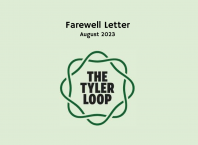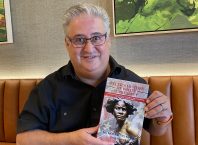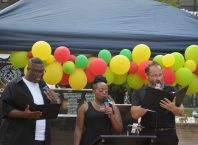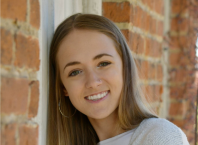On Mar. 2, 2020, the coronavirus was declared a global pandemic, forcing us to change almost everything we knew about well, everything.

Whether acknowledged or unspoken, COVID-19 has taken something from each of us. Whether we have lost a loved one to the virus, learned to thrive in a virtual environment or had to navigate politically-charged decisions like getting vaccinated and wearing a mask, no one has been left unaffected.
But while we’re all doing our best to dig ourselves out of the trenches and settle back into a somewhat normal routine again, medical professionals in the hospitals have taken residence right in the middle of the very place we’ve been trying to escape and avoid.
Data can give an idea of the state of things, but doctors, nurses and other healthcare workers don’t have the privilege of seeing just the numbers. Each number is matched with a face, a bed, a life, a family.
A year a half later, and they’re still there, fighting the fight we don’t often see.
The Tyler Loop reached out to four workers in the East Texas medical scene to learn what it’s really like in hospitals right now. Three of the four interviewees will remain anonymous due to professional medical guidelines.

“And when I went to leave, she grabbed me, to keep me there for a little bit longer.”
Emily Pitcher is a 21-year-old level 4 nursing student at the University of Texas at Tyler.
She fulfills most of her clinical hours at Christus Mother Frances Hospital, and recently, her shift took place in the COVID unit.
“Now that the numbers have increased again, the COVID patients are kind of all over the hospital, but specifically in the COVID unit, it’s just really hard to see.”
Often, harrowing sounds from the unit meet Pitcher before stepping foot into the room. “You can just hear all types of things — ventilators, crying. There’s a lot going on, and sometimes it’s just a lot of chaos.
“Constantly there’s monitors going off because somebody’s oxygen saturation is going down into the 60s or something, and that happens probably every 20 to 30 minutes for the whole 12 hour shift,” she said.
Though Pitcher has been with patients throughout the hospital, what she experienced in the COVID unit was unlike anything she’d experienced before.
“It can be really overwhelming, especially since it was my first time there. But it’s a lot of these nurses’ and doctors’ new normal. You know, they’re not fazed by this stuff anymore.
“But even going to nursing school all throughout the pandemic, it was still shocking to me how bad it is. It really is.I knew it was bad, but it’s just when you get to see it firsthand like that, it’s different. It’s a different experience.”
Visitors have been limited in the COVID unit, and Christus requires that loved ones talk over the phone through a door.
“The doors on this unit have windows, and so they can open the blinds on the windows and allow the families to see their loved ones through these windows.
“It’s really hard to watch these loved ones basically yell at each other through the door,” said Pitcher. “And these people are dying and they can’t touch their family. They can’t be there for their family, and it’s just incredibly sad.”
The politically charged climate around the response to COVID has also affected Pitcher.
“And then to think about all the people who say it isn’t real or ‘I’m not going to get my COVID vaccine because it can cause infertility’ and all of this other stuff that people are coming up with, it just makes it even more incredibly difficult.”
During this particular shift in the COVID unit, Pitcher said she held the hand of a woman who desperately needed the support of a loved one, but her room was empty.
“She’s been in the hospital for days on end and hasn’t seen any of her family. And she has this big oxygen mask on her face constantly, and she just started panicking. That’s understandable, because she doesn’t have anybody there,” said Pitcher.
“I got to hold her hand for a few minutes, but I had to go do the rest of my shift. And when I went to leave, she grabbed me, to keep me there for a little bit longer.
“And it just really hit me: She really just needed someone in that moment and there wasn’t anybody there for her.
“And so I stayed for as long as I could. But it’s just really hard to think about all the people who don’t have that or don’t even have the nurses [with] time to even hold those patients’ hands, or who don’t have family that can come to you even through the window.”
Pitcher says she wishes people would be more considerate of others’ health. “Be safe. Not just safe for yourself; safe for the people around you. And I’m not just talking about family and friends. I’m talking about your neighbor.”

“I’ve taken two showers a day for the last two years.”
A male healthcare worker in Tyler spoke more about the lengths he goes to to protect himself and his family, the unknowns of the virus and the frustration of the varied response to the COVID vaccine.
“That’s a hard thing for people to face. We’re kind of like Typhoid Mary to our families. I’ve taken two showers a day for the last two years because when I go to work in the morning, I take a shower. [Then I] come home, come in the back door, take off all my clothes, put them in the washer myself and go straight to shower,” he said.
“I know most doctors do that even though it’s probably a little bit of theater. We know that it’s a respiratory virus and you mainly spread it by respiratory spread, but we’ve got to do everything possible, and that’s the one thing to not bring in your house.”
While others at home were struggling to keep up with the news about the virus, healthcare professionals all over the world were struggling to keep up with the virus itself.
“This was a brand new virus … out of the woodwork and we had to learn it really, really fast. And that caused a lot of the confusion people have. We were confused and to be honest, we didn’t know how to treat this disease.
“We were kind of grasping at straws when we first started trying to to use our past knowledge of how similar things act and translate that into this new disease and then set up protocols and ways to to try to learn,” he said.
As the pandemic went on, they started to recognize a pattern in patients and their cases.
“The first half of the illness — the first year, the first wave, and the first variant — it was pretty specific. It had older people and people with a lot of comorbidities and a very predictable pathway of about seven to 14 days. If they made it through those 14 days, you’re going to be fine.
“And if you didn’t, you just kept on getting worse and ended up in the ICU. But then when you went to the ICU, most people still got better. You know, we could get them through it.”
The light at the end of the tunnel? Vaccines.
“Then we all got vaccinated. The first rush was just so great, because we all felt confident we weren’t going to get sick. Our staff wasn’t going to get sick and we weren’t going to lose a colleague — although in the first [wave], we lost some very close people to us.
“But once we got vaccinated, [we thought] ‘This is great, we’re all going to get the vaccine. Everything will be fine.’ Every doctor and every nurse that is well-versed in scientific principles wanted to get the vaccine and we all got it.”
However, the reality of public opinion came striking down in divided discourse.
“We were shocked that our patients were nervous about it. We said, ‘Look, we all got our family vaccinated.’ And they go, ‘That’s not good enough for us.’
“They wanted some kind of thing to make all of the questions go away.That’s where the science got in the way a little bit. It works 95% of the time. So then we started trying to figure out why it doesn’t work five percent of the time. But people hear the opposite. They go, ‘It doesn’t work.’”
Despite avid approval from healthcare professionals everywhere, people still remained wary.
“Through May, June, July, only half people got vaccinated and it just shocked us. We were all really disappointed and depressed that people didn’t get the vaccine, when we feel very, very confident that it’s …the best treatment we have. Everything else we have is way less effective than the vaccine.”
Though the vaccines and boosters have brought hope, medical centers everywhere are still struggling to treat those with the coronavirus and now the Delta variant.
“The treatments don’t work very well, because they’re not really treatments. They’re supportive care. The monoclonal antibody can work, but you’ve got to do it at exactly the right time. And a few of our medicines help.”
“But they don’t actually cure the virus. You have to get over it on your own. So that was bad enough that we got through that, and then this Delta came back and it’s different, and it’s scary.”
Delta brought new patterns and favored new specificities, the effects of which are not often realized to the public.
“It is heart wrenching, because you just don’t have good enough treatments to promise them, ‘I can get you well,’ and to not be able to say that — it’s different than most of us have ever dealt with.
“In a case like this, a certain percentage of people, you do everything right and they don’t get better, and it just is devastating. We think they’re going to be okay, and then all of a sudden they’re not. Everything we tried didn’t work.
What stings the most for some healthcare professionals is the sudden lack of trust.
“I feel terrible. All of a sudden, something made [people] quit trusting me. Don’t be so skeptical that people in medicine and science have any ulterior motive except to help. That’s why we do what we do.
“[You] use your wisdom and try to figure things out for yourself. But you have to listen to people that really know a lot more than you do and trust them when they’re telling you, and they’re doing it for themselves.”

“It’s depressing. We had over nine patients die in a couple of hours.”
A 22-year old male level 4 nursing student at UT Tyler has done many of his clinical hours in the COVID ICU at UT Health Science Center.
“It’s depressing. We had over nine patients die in a couple of hours. If somebody expires or is just turned off, they’ll cross each other in the halls just because the turnaround is so quick.
“They have so many people that are just around the hospital waiting to go to the ICU or just in beds in general.”
Though the Delta variant has created a new virus surge, COVID restrictions in Texas were already lifted, allowing other kinds of hospital patients to enter.
“They’re starting to add in elective surgeries and elective procedures. That’s backing everything else up. Because all the people [whose surgeries and procedures were] canceled a year ago are coming in, it’s filling up the hospital even more. Plus all the COVID that’s coming in.”
Though hospital beds are full right now, it is difficult to keep nurses on staff.
“From a nurse’s standpoint, all the nurses are leaving their home hospitals because bigger hospitals are offering thousands of dollars a week for travel nurses to come help with the overflow and patient loads. This is really putting a financial strain on most of the smaller hospitals, because they can’t keep affording to pay those wages.”
He stresses the importance of recognizing the pandemic is still active and taking action to prevent unnecessary risks. “Take it seriously. Because you really don’t know what you might cause if you don’t wear your mask in public. Just wear your mask in public, it’s not hard.”

“We were overflowing into non-COVID areas, and it got to the point where we were just reducing COVID admissions.”
A female health professional in Tyler spoke about hospitals everywhere being filled to max capacity due to the Delta variant, the struggle of the vaccine debate and the importance of investing in your health.
“We’re seeing a lot of really young people this time around. It’s very different from our second surge, which was last fall and winter. We have people in their 20s on ventilators or people in their 20s and 30s.
“I feel like the people who are being hospitalized now are way sicker than they were a year ago. Things are actually picking up, and getting a little better right now. But about a month ago, we were actually discharging people from the ER with oxygen.”
“If this were the second surge, we would have admitted those people. People with no oxygen requirements require admission. We had essentially no more rooms here.
“We were overflowing into non-COVID areas, and it got to the point where we were just reducing COVID admissions, which is really unfortunate.”
Even those with life-threatening injuries were being turned away due to the lack of bed space.
“I remember one lady had some gangrenous changes in her legs. She needed to be hospitalized. I was calling places in Austin, Houston, Temple, Texas, looking for an open bed. But she would require ICU care afterwards.
“She was COVID negative, and no one had a bed for her. So she stayed in our ER for a day and a half, which is really frustrating, providing no ICU level of care in the ER.
“But you know, [the ER] is meant to triage needs and pass them on to whoever is going to care for them. So that was one month ago. A lot of that is frustrating, turning people away who needed urgent care, who needed hospitalization — just because we didn’t have the beds.”
Despite much medical urging to get the vaccine, backlash continues.
“I think one of my greatest frustrations now is that I feel like a broken record trying to convince people to get the vaccine.
“People will come and see us when they’re feeling unwell. But when things are well, they prefer to take their advice from the comment section of the internet, which is just so frustrating,” she said.
“So there’s no consistency and the standard of care that they apply to themselves, where they’re kind of showing up last minute, hoping that we fix them or hoping that the result of their poor decision can be managed.
Tensions in hospitals run high as patients resist the possibility they have COVID.
“Some of the angriest patients I’ve had in the clinic in the last month have been unvaccinated people who are in denial that they have COVID. They’re like, ‘Oh, it’s sinusitis, I have bronchitis.’
“Even if they believe their diagnosis, they’re just very resistant. They’re like, ‘Well, what are you going to do to fix me?’ And I’m like, ‘I don’t know. Can’t fix you now, here’s some steroids. Good luck.’”
Among the drama of the vaccine debate and recent restrictions within Texas, many healthcare professionals are finding themselves desensitized to the deaths by COVID.
“… all the deaths we’ve had in the last probably two months, it’s like, ‘Okay, they’re dead. Next person.’ It doesn’t carry the emotional weight of a year ago, because the people who died a year ago, when we talk amongst ourselves, if we still remember them, we feel such deep sadness knowing that they were kind of inevitable outcomes,” she said.
“With patients dying now, there’s a sense of, ‘Well it’s a result of poor decision making,’ and then I think of the families… feeling the family pushing back, saying, ‘Why aren’t you doing this, why aren’t you doing that?’
“I feel like we’re fighting the family. We’re fighting the patients. And ultimately, even if there is a bad outcome, it just doesn’t carry the emotional weight like it did earlier in the pandemic. A lot of us are pretty numb to it now.”
She wishes people would understand the importance of constantly maintaining their health, especially amid the pandemic. “Health is wealth. It really is. There are no last minute, last ditch cures to a lifetime of poor decisions.”
Though each healthworker had varying experiences, a common theme appeared: COVID is dire, and the moment calls for self and social responsibility.
Love what you're seeing in our posts? Help power our local, nonprofit journalism platform — from in-depth reads, to freelance training, to COVID Stories videos, to intimate portraits of East Texans through storytelling.
Our readers have told us they want to better understand this place we all call home, from Tyler's north-south divide to our city's changing demographics. What systemic issues need attention? What are are greatest concerns and hopes? What matters most to Tylerites and East Texans?
Help us create more informed, more connected, more engaged Tyler. Help us continue providing no paywall, free access posts. Become a member today. Your $15/month contribution drives our work.







